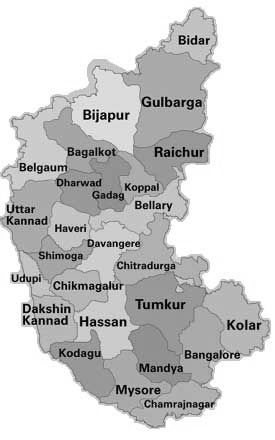

This report is in relation to the conditions in Bellary District of Karnataka
In the mine field of exploitation
They suffer in silence. Poverty and lack of alternatives force them into the mines, from where the unfortunate women don't find a way out, says M C Shivkumar.
A cloud of dust obscures the sunlight, as the women work for 10 hours, unmindful of the aching bodies and the dangers posed by the environment. Considering the extensive underground and open-cast mining operations across the country, we would know what these poor women get as wages, food security or safety.
In Karnataka, mining would remind us of Bellary District and the plight of poor women labourers working in them. Visit to the region would reveal their sufferings for a meagre income in the mines, which are scattered across the district.
In a place suffering from four consecutive years of drought, mining does come as a saving grace and keeps life going for the local people. But for women, the mines (from where tons of metallic and non-metallic manganese and iron ore are extracted and exported to China, Japan, Pakistan, and Korea through Mangalore, Karwar, Goa and Chennai) is nothing but hell.
Out of 99 government-sanctioned mines in Bellary, 58 are functional and the others are closed down over the years for different reasons.
Local police sources claim plenty of unauthorised mines exist in the district, while the Mining and Geological Survey of India officials say illegal mining takes place even in the authorised mines (so that minors can evade paying tax).
In this atmosphere of corruption and greed, women's right and safety seems hardly an issue. Forced to the mines by prolonged poverty and backwardness, the 20,000 women work in potentially hazardous conditions, contrary to claims by minors that safety has been provided for them.
According to the labour laws, these women - involved in unloading, stone-crushing, loading the ore to the tippers and goods wagons - should have been given safety equipments like gloves and masks. But, the laws are clearly in breach here.
Those in the unorganised labour sector have to work in late hours, during advanced pregnancy and without facilities like maternity leaves or creche. What more, they work in constant fear of being thrown out of work. In some quarries, women are sexually abused in late hours.
Along with the women, their children, left alone in the quarry while their mothers work, are also exposed to the hostile conditions. Working for long hours, women folk may get between Rs 25 to 30, while men are paid between Rs 35-40. Whereas the women involved in loading the ore get a paltry Rs 18.

(SLAVE LABOUR conditions in hospet,Bellary ! )
The adverse health situations among these women haven't been subjected to scientific studies.
Reports by health department and the government haven't yet been publicised. Enduring all this looks meaningless for local women, as minors bring migrant workers -both men and women-to work here.
The danger however, seem to be the same for both the local and migrant women, who are exploited by company staff, contractors and migrant male workers. This situation breeds further uncertainties, as the migrant population has brought with it sexually transmitted diseases like HIV/AIDS.
"It's highly likely that the migrant workers from Andra Pradesh would spread HIV among local population," says Dr Bhagyalakshmi, director of a local NGO: Sakhi. Her fears are confirmed by Dr Prahlad, convener, Bellary AIDS Prevention Society: "AIDS is rapidly spreading in the district and the migrant workers are, no doubt, responsible for this."
Shalini, a post graduate student of Hampi University, says cases of sexual abuse by male workers do come to the surface, but reeling under poverty and suffering from health problems, she admits these women can do very little in reality. Not stopping with women, Bellary's mining industry has started luring child labour.
Even for the adults, mines are the only way to survive, with long drought and lack of alternative income-sources. "My face starts itching. I constantly get nausea and unable to eat," says Malligavva of Karigallu village, a worker in the mine.
As agriculture proved useless, Malligavva sold his two-acre land for Rs 35,000 an acre to take up mining. In Bellary, stories of mine workers aren't different from Malligavva. Though there are 5,432 mine workers in the district, the numbers in the unorganised sector is considered to be around two lakhs, 35 percent of whom are women.
These women are in urgent need of safety gears, pure drinking water, equal wages and privileges granted in the labour law. The fact that labour unions, which frequently obstruct city-life with bundhs, have so far turned a blind eye to the women's plight.
Ironically, politicians can't come to their rescue as well, since MP's and MLA's own most of the mines here. Now at least, there seem to be no answers to their woes.
This article was written under the fellowship of CSE, New Delhi.
http://www.deccanherald.com/deccanherald/nov222005/spectrum1404520051121.asp
Related posts
BJP Scums buys helicopter in bellary
Children of the pits
There were other options rather than buying a helicopter, he could have built the roads, so he could travel in the car to attend to the people's needs and at the same time people living there would have better roads to travel on. Who do you think he is fooling by saying it is going to help him attend the people's needs. Plain old, Dirty Politics.
ReplyDeleteRight said Anonymous
ReplyDelete